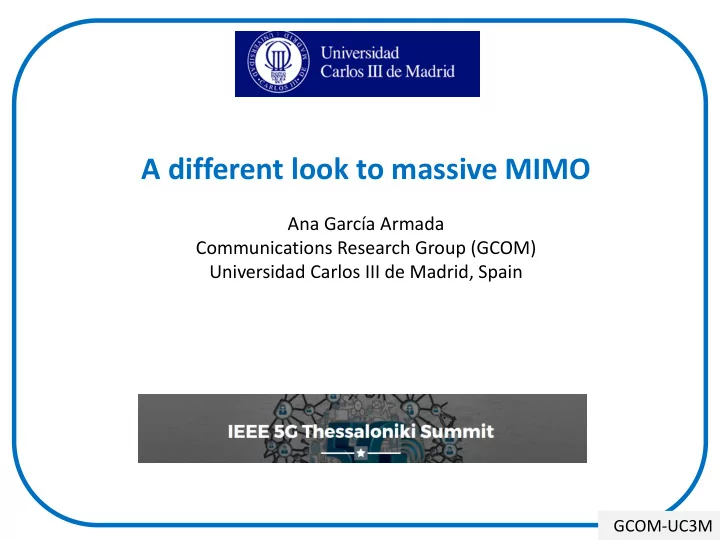

A different look to massive MIMO Ana García Armada Communications Research Group (GCOM) Universidad Carlos III de Madrid, Spain GCOM-UC3M
Agenda Introduction to Massive MIMO Wearable massive MMO Non-coherent massive MIMO Conclusions TSC. Grupo Comunicaciones 2 GCOM-UC3M
Introduction New requirements call for new technologies Energy- and spectral- efficiency of massive MIMO Need low-complexity solutions with reduced feedback TSC. Grupo Comunicaciones 3 GCOM-UC3M
Massive MIMO Benefits of increasing (a lot) the number of antennas • Improve data rates and reliability (multiplexing and diversity gains) • Decrease required transmit power • Very simple precoders/decoders TSC. Grupo Comunicaciones 4 GCOM-UC3M
Massive MIMO – most usual configuration Asymmetry in the number of antennas at both edges MU- massive MISO … MU- massive SIMO … K single antenna users, K << R R antennas at BS, R >> Time division duplex (TDD) • the required channel estimation for precoding and coherent detection is feasible • calibration to compensate the differences in RF is needed • pilot contamination remains as a problem to solve TSC. Grupo Comunicaciones 5 GCOM-UC3M
Why not using massive MIMO also at the UE? In terms of capacity for a given user, MIMO 2 x 2 is better than x 1 How to accommodate a massive number of antennas at the UE? TSC. Grupo Comunicaciones 6 GCOM-UC3M
Wearable Massive MIMO hub with textile antennas MIMOtex is a wearable antenna hub at the user end to which any data-enabled device can connect • to dramatically boost symmetric wireless capacity, • without compromising device size and weight Examples of textile antenna arrays deployed at user clothing [3] M. Sanchez- Fernandez et al. ,“Blended Antenna Wearables for an Unconstrained Mobile Experience”, IEEE Comm. Mag. Vol. 55, no. 4, pp. 160 – 168, April 2017 TSC. Grupo Comunicaciones 7 GCOM-UC3M
Improving throughput and/or coverage Average UL throughput Percentile of users achieving a certain uplink throughput bandwidth of 5MHz and 64 antennas at BS TSC. Grupo Comunicaciones 8 GCOM-UC3M
Prototype Focus on the UL to reduce the impact on the BS Very light antennas (3 grams) • The substrate used is common felt • The metallization is implemented with electrotextile materials Inter-element distance of (8 cm) @2.5GHz. Real 5x3 textile prototype developed at UC3M TSC. Grupo Comunicaciones 9 GCOM-UC3M
Non coherent communications – why now? 3 dB loss of non-coherent (NC) vs coherent (C) processing When we consider the needs of channel state information (CSI) obtaining and sharing, this loss may become negligible • A. Goldsmith’s work: To train or not to train? Channel estimation is wasteful in some circumstances (channels with low coherence time, low SNR) NC massive MIMO: the perfect match! • The “magic” of massive MIMO (self interference cancellation) may improve NC performance • CSI estimation and sharing is vey complex in massive MIMO (pilot contamination ...) TSC. Grupo Comunicaciones 10 GCOM-UC3M
Multi-user Large Scale single input-multiple output (SIMO) uplink [4] One base station (BS) with R receive antennas K Mobile Stations (MSs) with single antenna Data symbol sequences s j [ n ] ( j =1,… K ) are M-PSK: | s j,m [ n ]|= 1 Tx signal at time instant n comes from differentially encoding s j [ n ] : MU- massive SIMO … … [4] A. G. Armada and L. Hanzo , “A Non -Coherent Multi-User Large Scale SIMO System Relying on M-ary DPSK,” IEEE ICC, Jun. 2015 pp 2517 - 2522. TSC. Grupo Comunicaciones 11 GCOM-UC3M
Performance – 2 users, DQPSK, SNR=0 dB 0 10 -1 10 -2 10 simul [REF] [5] upper [REF] Design A -3 P e 10 Design B -4 10 -5 10 -6 10 1 2 3 4 10 10 10 10 R [5] M. Chowdhury, A. Manolakos , A.J. Goldsmith, “CSI is not needed for Optimal Scaling in Multiuser Massive SIMO Systems,” Proceedings of ISIT., Honolulu, July 2014. TSC. Grupo Comunicaciones 12 GCOM-UC3M
Number of antennas vs coding rate TSC. Grupo Comunicaciones 13 GCOM-UC3M
Conclusions Massive MIMO: energy- and spectral-efficiency • Theory well established • It is time to solve implementation issues Massive textile antenna hub to implement Massive MIMO at UE • User throughput and coverage improvements Non-coherent DMPSK for massive MIMO does not need CSI • Coding reduces the number of antennas to feasible values TSC. Grupo Comunicaciones 14 GCOM-UC3M
Thank you! This is joint work with : • Matilde Sánchez-Fernández, Eva Rajo-Iglesias, Antonia Tulino, Jaime Llorca, Estefanía Crespo (MIMOtex) • Victor Monzon Baeza, Wenbo Zhang, Mohammed El-Hajjar, and Lajos Hanzo (non-coherent mMIMO) Ana García Armada agarcia@tsc.uc3m.es TSC. Grupo Comunicaciones 15 GCOM-UC3M
Recommend
More recommend